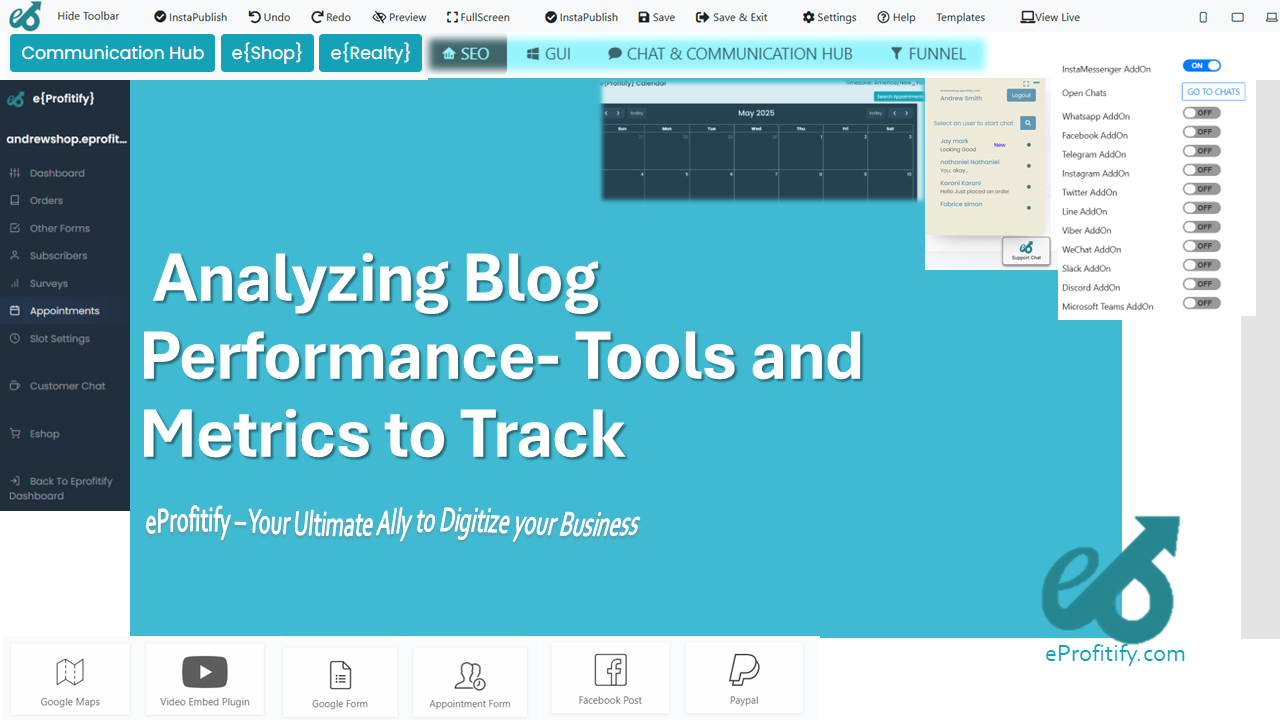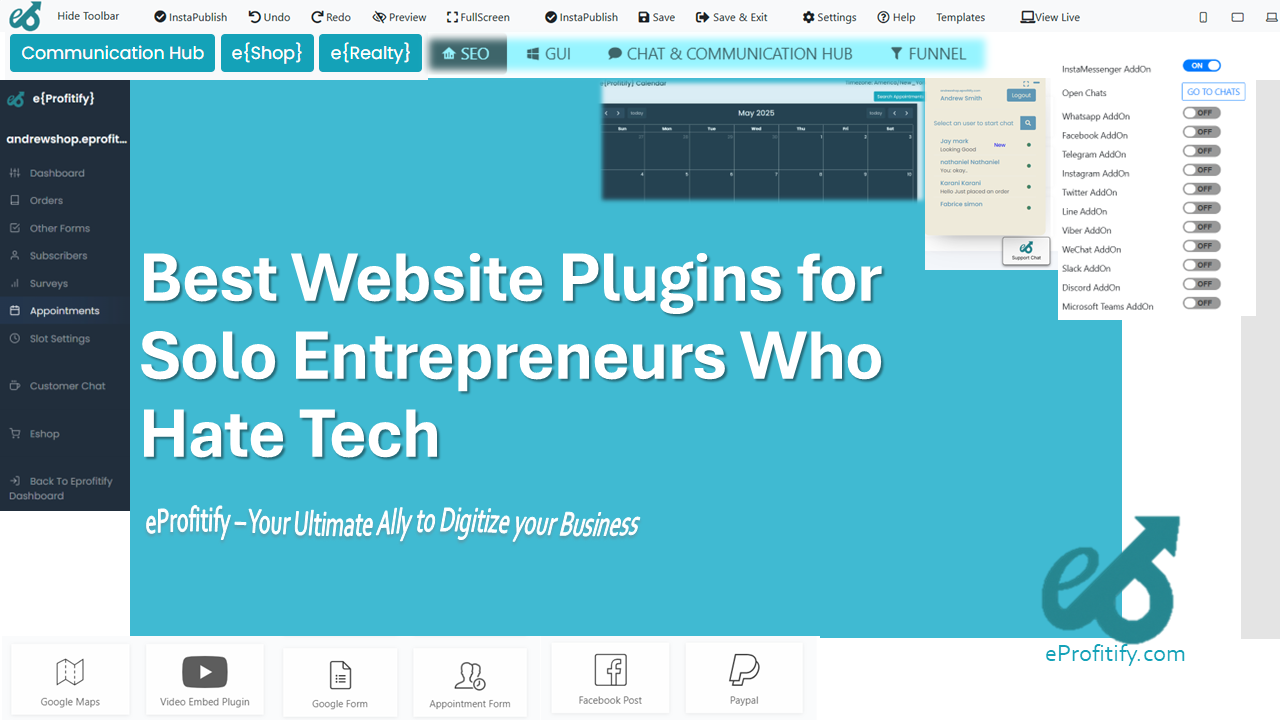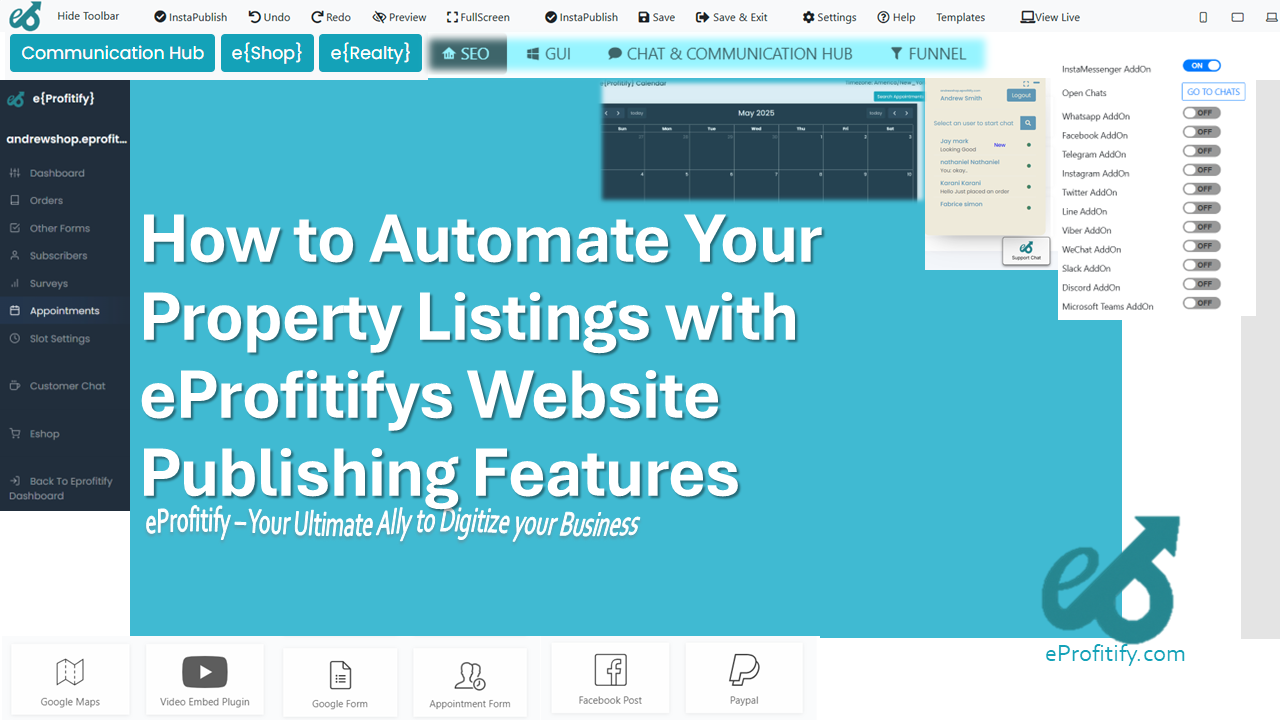Analyzing Blog Performance- Tools and Metrics to Track

Analyzing Blog Performance: Tools and Metrics to Track
Unlock Growth with Data-Driven Insights and Eprofitify’s All-in-One Solution
In the competitive digital landscape, analyzing blog performance is critical for refining strategies, engaging audiences, and driving conversions. With 86% of companies leveraging blogs for marketing (HubSpot, 2023), understanding key metrics and utilizing the right tools can transform your content into a growth engine. This guide explores essential metrics, industry-leading tools, and how Eprofitify—a holistic website management platform—empowers businesses to streamline performance tracking while integrating advanced features like CRM and ecommerce.
Why Blog Performance Analysis Matters
Blogs are pivotal for SEO, lead generation, and brand authority. Companies with active blogs experience 434% more indexed pages (Tech Client, 2022), amplifying visibility. However, success hinges on continuous analysis. By tracking metrics like traffic, engagement, and conversions, marketers optimize content, allocate resources effectively, and achieve 3x more leads than outbound strategies (DemandMetric).
Key Metrics to Track
1. Traffic Metrics
- Sessions/Users: Measure total visits and unique visitors. A higher user count indicates growing reach.
- Pageviews: Reflect content popularity. Blogs with diverse topics often see increased pageviews.
- Traffic Sources: Identify channels (organic, social, direct) driving visits. Organic search dominates, accounting for 53% of global website traffic (BrightEdge, 2023).
Statistic: Websites prioritizing blog content observe a 55% increase in organic traffic year-over-year (HubSpot).
2. Engagement Metrics
- Bounce Rate: The percentage of single-page visits. Aim for <50%; the average is 40-55% (Google Analytics).
- Average Session Duration: Target >2 minutes. Content that educates or entertains retains users longer.
- Pages/Session: Higher values (2-3) suggest readers explore your site beyond the blog.
Statistic: Engaging blogs can reduce bounce rates by 30%, boosting SEO and conversion potential (SEMrush).
3. Conversion Metrics
- Click-Through Rate (CTR): Track links to product pages or CTAs. A CTR of 1-5% is typical.
- Conversion Rate: Measure sign-ups, downloads, or sales from blog referrals. Top-performing blogs achieve 5-10% conversion rates (Unbounce).
- Revenue Attribution: Tools like Google Analytics 4 (GA4) link blog visits to sales, essential for ROI calculations.
*Statistic: Content marketing delivers 6x higher conversion rates** than traditional methods (ABGAZZ).
4. SEO Metrics
- Keyword Rankings: Track positions for target keywords. First-page rankings capture 71% of clicks (Backlinko).
- Backlinks: High-quality links boost domain authority. Blogs earn 97% more inbound links than static sites (HubSpot).
- Page Speed: Pages loading in <2 seconds reduce bounce rates by 38% (Portent).
Tools for Analyzing Blog Performance
1. Analytics Platforms
- Google Analytics: Free, robust tracking for traffic, behavior, and conversions.
- Eprofitify Analytics Dashboard: Integrates traffic and conversion data with CRM insights, offering a unified view of blog-driven customer journeys.
2. SEO Tools
- Ahrefs/SEMrush: Audit keywords, backlinks, and competitor gaps.
- Google Search Console: Monitor organic performance and indexing.
3. Content Optimization
- Clearscope/Grammarly: Enhance readability and SEO alignment.
- Eprofitify Content Hub: Streamline SEO audits and topic clustering within its platform.
4. Social Media & Engagement
- Hootsuite/Buffer: Schedule posts and track social shares.
- Hotjar: Heatmaps reveal user behavior patterns.
Eprofitify: Elevating Blog Management with Integrated Solutions
While specialized tools excel in individual areas, Eprofitify stands out as an all-in-one platform merging analytics with business operations. Designed for efficiency, it simplifies tracking while enhancing user engagement and conversions through:
- Unified Analytics Dashboard: Track traffic, conversions, and SEO performance without switching tools.
- CRM Integration: Link blog leads to customer profiles, nurturing them via personalized workflows.
- Ecommerce Tools: Attribute sales to specific posts, monitor cart abandonment, and upsell via embedded product widgets.
- Instant Messaging: Engage visitors in real-time, reducing bounce rates and boosting session duration.
- Appointment Management: Convert blog readers into clients with in-post booking widgets.
Statistic: Businesses using integrated platforms like Eprofitify report 40% faster decision-making due to centralized data (Gartner).
Conclusion
Analyzing blog performance requires a strategic blend of metrics and tools. Traffic, engagement, conversions, and SEO form the foundation of success, while platforms like Google Analytics and Ahrefs provide actionable insights. However, Eprofitify redefines efficiency by combining analytics with CRM, ecommerce, and engagement tools—empowering businesses to manage their blogs and grow revenue seamlessly. In an era where 70% of marketers prioritize content quality over quantity (HubSpot), leveraging Eprofitify ensures your blog isn’t just a content hub, but a dynamic driver of growth.
By adopting a data-centric approach and integrating versatile tools, businesses can transform their blogs into powerful assets that captivate audiences and fuel long-term success.








